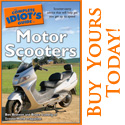Last update: April 14, 2005 at 7:06 AM
Commuters go for scooters
Susan E. Peterson, Star Tribune
April 14, 2005 SCOOTER0414
If recent sales trends continue, Twin Cities streets will be looking a little more like those in Paris, Rome and Amsterdam this summer, with a growing fleet of fuel-thrifty motor scooters zipping along among the gas-guzzling SUVs, sedans and pickups.
In February, long before the scooter-riding season starts in Minnesota, customers began flocking to Scooterville, a Minneapolis dealership near the University of Minnesota campus, looking for a cheaper commute.
“It really threw us,” Scooterville owner Bob Hedstrom said. “We usually do a certain amount of early sales in March, but this year February was when it really started to take off. People would come in and say, ‘I’ve got a 7-mile ride to work — what do you have that will handle that?’ There’s been a lot more discussion of fuel efficiency than there’s ever been in the past.”
Scooters on display at Scooterville.
Tom Sweeney
Star Tribune
Hedstrom said sales so far this year are about double last year’s and already have surpassed sales for Scooterville’s first year of business, in 2001.
Nationwide, scooter sales have been on the upswing for the past few years, according to the Motorcycle Industry Council, a trade group.
The group doesn’t record data for all brands, but for the ones it tracks, such as Honda, Yamaha and Vespa, U.S. sales jumped from 42,000 units in 2000 to an estimated 86,000 in 2004.
Kent Aldrich showed off his scooter.
Tom Sweeney
Star Tribune
And even though it has a relatively short scooter-riding season, the Twin Cities area ranked fourth in scooter sales among major metro markets in 2003, the council said, outpacing Miami, Denver and the San Francisco Bay area. The top three are Los Angeles, Chicago and New York City.
Matt Nelson, a salesman at Honda Town in Minneapolis, said rising gasoline prices are driving the current rush for scooters. “It’s crazy right now,” he said. “We just had a guy, 70, come in who’d never been on a motorcycle in his life, and he spent $2,000 to buy a scooter. He said it was because of the gas prices.”
Hedstrom said there isn’t a typical scooter customer anymore.
“When I did my business plan, I was anticipating a much younger demographic — people in their 20s and early 30s,” he said. “But I sell to more people in the 50-65 range than in their 20s and 30s, and some are as old as 75. Some are still riding in their 80s.” The male-female split is about 50-50, he said.
Monica Johnson-Null stopped in at Scooterville Wednesday to pick up her new Stella scooter, a popular midrange model with a top speed of 55 to 65 miles per hour and gas mileage of 70 to 80 miles per gallon. It cost about $3,300, including taxes.
Johnson-Null, who traded her motorcycle for a car last summer, said she wanted to get back on two wheels.
“You can park it at bike racks, zip around town, and with the cost of gas right now, it makes sense … and it has enough oomph for the highway,” she said. She lives in northeast Minneapolis and plans to use it to commute to her jobs at Fairview-University Medical Center in Minneapolis and the REI store in Roseville.
“And it’s not just gas prices,” she said, citing insurance costs of about $4 a month, a big bargain compared with auto insurance.
For the lowest-powered scooter models — those with engine sizes of 50 cubic centimeters or less and top speeds of 30 miles per hour — Minnesota riders don’t need a motorcycle endorsement on their driver’s licenses. They do, however, need a driver’s license or permit, so riders must be at least 15 years old.
The low-power models are called mopeds, even though scooters that actually can be pedaled generally aren’t sold anymore. The mopeds are a popular choice for city dwellers, because they’re easy to ride and less expensive, generally in the range of $1,700 to $1,800.
Midrange models, 150 to 250 cubic centimeters with top speeds of 55-70 miles per hour, generally cost $2,500 to $5,500. And Honda has a 600 cubic centimeter model with a top speed of 110 miles per hour that sells for about $8,000.
Gas mileage runs from 90 to 100 miles per gallon for the under-50 cc models to 60 to 70 miles per gallon for the bigger engines, depending on how they’re driven.
And then there’s the option of using no gas at all — Scooterville sells an electric bike called the eGo that will run 20 to 25 miles on a 3½-hour charge, with a top speed of 20 to 25 miles per hour. It costs about $1,500 and can be decked out with side baskets and a small trailer, making it ideal for around-town shopping trips, Hedstrom said.
Pete Johannsen, a salesman for Moto Primo, a Minneapolis dealer of Vespa and Yamaha scooters, said the craze goes beyond the desire for cheap transportation.
“There’s a ‘cool factor,’ ” he said. “To own a Vespa is a huge stylin’ thing.” The customers he’s seeing “are such an eclectic group,” he said, ranging from south Minneapolis couples buying twin scooters to tool around the lakes to a cab driver who has loaded extras on his scooter “till it looks like a pseudo-Harley.”
While fuel economy is helping to drive the current sales boom, a fair number of people buy scooters just for the fun of driving them, dealers said.
Kent Aldrich rides a stylish green Stella bristling with mirrors and other cool accessories. He runs a print shop and uses the scooter to make deliveries and pick up supplies, as well as riding for pleasure whenever he gets the chance.
“It takes a little more time to get there, but it’s a lot more fun,” he said.
Staff librarian Sandy Date contributed to this report.
Susan E. Peterson is at sepeterson@startribune.com.















Mon, Apr 25, 2005
News